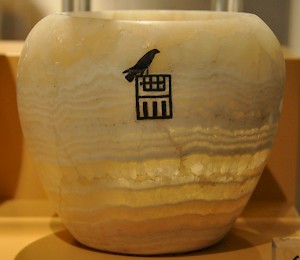Djer
King Djer: probably the third king of Egypt's First dynasty, ruling in the second half of the thirtieth century BCE.

Among the First Dynasty tombs that were uncovered in the Umm-el-Qaab necropolis of Abydos, was the final resting place of a King Djer, called "Tomb O". If the seal impressions found in another tomb, King Den, correctly represent of the royal lineage, which assumedly passed from father to son, Djer was the grandfather of Den. The names appear on the usual archaeological objects such as year tags, steles, vases, pots, and jars, but also in inscriptions and seal impressions found in contemporary tombs in Saqqara.
King Djer presumably ascended the throne at a young age and may have been assisted by his (grand)mother Neithhotep. He is believed to have put a lot of effort in bringing the peoples of Upper and Lower Egypt closer together. To that end, he paid (according to an ivory label from his tomb) a visit to Buto and Dep, two cities located in the Nile Delta (Lower Egypt), which were slowly fusing.
Buto was the counterpart of Hierakonpolis in Upper Egypt and was known for its worship of the goddess Wadjet. This goddess graced the headdress of pharaoh in the form of an upright cobra (uraeus) and represented Lower Egypt. Her other half was the vulture goddess Nekhbet who resided in Hierakonpolis and represented Upper Egypt. Together they were known as the “Two Ladies” and were connected with one of the pharaoh’s five kingly titles: the Nebty name.
As was common in that age, the tomb of King Djer in Abydos ("Tomb O") was surrounded by burial sites, containing the remains of more than three hundred people, who appear to have been interred with the king.